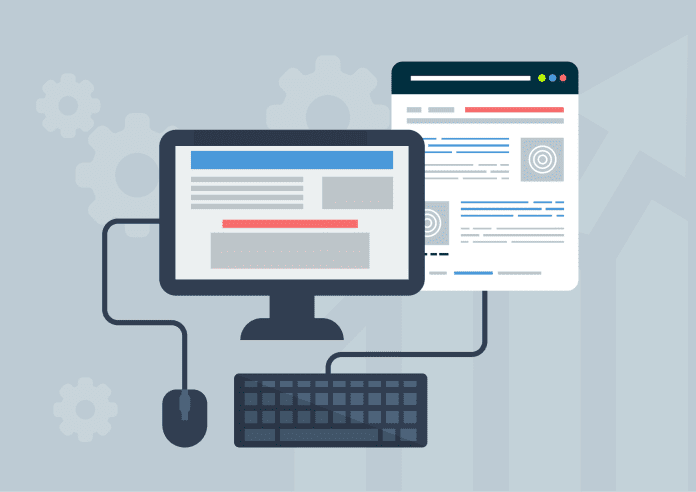Every business owner who came to me to redesign their website came amid one form of tussle with their old web designers, or another. And the stories are endless.
One even had her domain hijacked, and we had to start with a new domain. This is not right. Incidentally, Ghana has some very advanced IP and digital property laws as compared to many other African countries (such as the Copyright Act, Patents Act, Trademarks Act, and Industrial Designs Act).
Yet enforcement has always been the problem, and looking at how bad things are here, I shudder to think of what prevails in other jurisdictions in the sub-region.
That said, I have put together this comprehensive guide for SMEs and brands on how to protect their digital assets and thrive online.
Small and Medium-sized Enterprises (SMEs) face increasing challenges in controlling their digital assets, including domain names, website code, and software licenses. These issues frequently lead to “website hostage” situations and costly vendor lock-in when engaging with external web designers. This article examines the causes of these disputes, explains their impact on SMEs, and provides a strategic framework for proactive protection and dispute resolution, empowering businesses to secure their online presence and ensure uninterrupted operations.
A robust online presence is essential for SMEs today. Websites, along with their associated domains and digital tools, form the foundation of brand identity, customer engagement, and revenue generation, effectively acting as an SME’s digital storefront. However, many SMEs find themselves vulnerable. Complaints often involve web designers retaining control over domain registrations, premium WordPress plugin licenses, and platform access, especially when a client wishes to change developers. This lack of clear ownership can severely impede an SME’s ability to manage, update, or transfer its online presence, often resulting in significant business disruptions and financial losses. The increasing legal recognition of digital assets, even in arbitration, underscores their growing commercial importance.
Several common practices and misunderstandings frequently lead to SMEs losing control over their essential digital assets.
-
Domain Name Hostage
A common and problematic scenario occurs when web designers establish control over a client’s domain name, either inadvertently or intentionally. This often happens because the designer registers the domain on the client’s behalf but lists themselves or their company as the “Registrant,” the legally recognised owner, instead of the SME. To further obscure ownership, such domains are sometimes privately registered, making public verification of the legal owner difficult. In some cases, developers manage multiple client domains under their own “master Registrar account,” centralising control away from the client and creating a single point of failure.
If the web designer holds the domain, transferring ownership to the client becomes substantially difficult, particularly if the professional relationship deteriorates or the designer becomes unresponsive. This directly impairs the SME’s ability to switch web hosting or design providers, effectively trapping them with the initial vendor. In extreme cases, if the designer becomes unreachable due to disappearance or death, the SME may find itself without any legal or practical means to regain access or control of its domain name. While holding a domain hostage may not always be explicitly illegal, it is widely considered unethical and can lead to legal action if the designer refuses to relinquish ownership. The “Registrant” field is legally paramount, and the business owner should unequivocally be listed in this capacity.
A fundamental disconnect often exists between client expectations and legal realities, which contributes to these disputes. SMEs frequently assume that paying for website development inherently grants ownership of all components, including the domain name. However, web designers, whether through misunderstanding, oversight, or deliberate practice, may register the domain in their name or under a master account. The legal default for domain ownership rests with the “Registrant”. Consequently, the SME’s assumption of ownership is legally unfounded, leading directly to a “hostage” situation when attempts are made to assert control or transition to a different provider. This highlights the critical necessity for explicit contractual clauses and thorough client education regarding domain terminology and roles.
-
Premium Plugin and Software Licenses
Web designers commonly use their own “developer licenses” or “unlimited licenses” for premium WordPress plugins, themes, and other software during website development. While widespread, this is not necessarily a best practice from the client’s perspective. A key principle is that the individual or entity who purchases the service or license is its rightful owner. If the designer bills the client for a service but retains the underlying license, they effectively maintain control over that software’s functionality and updates.
This practice significantly impacts the client’s ability to maintain their website. Without possession of the license, the client will not receive crucial updates or support for the software if the designer becomes unreachable or the professional relationship concludes. This can result in technical issues, including layout inconsistencies, plugin conflicts, and, critically, unpatched security vulnerabilities. Outdated software, directly resulting from a lack of license access, presents a substantial cybersecurity risk for SMEs. In unfavourable scenarios, the client may be compelled to purchase their own licenses to restore full functionality and security, incurring unexpected and avoidable costs. There have even been documented instances where developers have been accused of “bait and switch” tactics, attempting to force users who had legitimately paid for “lifetime unlimited licenses” to agree to new terms or repurchase access.
The use of developer licenses by web designers, while seemingly a minor detail or cost-saving measure during initial development, often creates a hidden financial burden for the client. Developers may use their own licenses for convenience or to reduce upfront costs for the project. However, clients are frequently unaware that they do not own these licenses or of the long-term implications of this arrangement. When the professional relationship concludes, the client loses access to vital updates and support. This lack of ongoing updates inevitably leads to accumulating security vulnerabilities and functional issues over time. These accumulated issues then necessitate future, unplanned expenditures, such as purchasing new licenses, rectifying broken features, or addressing security breaches. This common practice effectively generates “technical debt” for the SME, where an apparent initial saving or oversight leads to substantial, unavoidable costs and risks in the future, compromising the website’s long-term viability and security.
-
Website Hosting and Platform Access
Similar to domain names, web designers sometimes host client websites as “add-on domains” under their own overarching hosting accounts. The established best practice, however, dictates that clients should possess their own independent hosting account with a distinct login and full administrative access.
A significant challenge arises when designers refuse to provide full administrator access to the Content Management System (CMS), such as WordPress, or to the hosting control panel. This restriction severely curtails the client’s ability to independently manage website content, user accounts, or install and update plugins. A refusal to grant hosting account administrator access is a substantial warning sign. If the developer controls all website files and databases within their account without granting the client access, they possess the unilateral power to shut down the site or completely lock out the client in a matter of moments.
The consequences of such limited access are severe. The SME is unable to perform independent updates, manage users, or even migrate its website without the designer’s direct intervention. This can lead to the designer effectively holding the “website hostage” by denying access, resulting in significant downtime and an inability for the business to conduct its online operations. Furthermore, a new developer cannot easily assume maintenance or development responsibilities without comprehensive access to both hosting and CMS platforms.
Many SMEs operate under the assumption that they control their website simply because they can log in and perform basic content edits. However, designers frequently provide only limited user access, not full administrator privileges or direct hosting control. This limited access creates an illusion of control, masking the underlying dependency on the designer for critical functions such as managing users, performing full backups, or making server-level changes. When the SME attempts to exercise complete control, for instance, by seeking to change developers, they discover they are locked out, which inevitably leads to disputes. This situation underscores that “access” is not synonymous with “control” or “ownership”. SMEs must understand the different tiers of access, user, administrator, and hosting root, and ensure they possess the highest level of control over their critical digital infrastructure.
-
Contractual Ambiguities and Intellectual Property Gaps
A pervasive issue in web design agreements stems from a lack of clarity regarding intellectual property (IP) ownership. Under common law copyright principles, the creator, typically the web designer or developer, is presumed to own the copyright in the works they create, including HTML, images, graphics, and code. This remains the default position unless ownership is explicitly transferred in writing. Merely paying for a website does not automatically transfer full ownership; it generally grants an “implied license” for the client to use the work for its intended purpose, but not the comprehensive right to modify, resell, or relicense it freely.
Many web development contracts fail to incorporate clear “work-for-hire” clauses or explicit assignments of copyright. A “work made for hire” is a specific legal exception where the hiring party is deemed the author and copyright owner from the moment of creation. However, this doctrine is subject to stringent legal requirements, particularly when dealing with independent contractors. For commissioned works by independent contractors, the work must fall into one of nine statutorily defined categories and be subject to an express written agreement designating it as “work for hire”. Notably, general software code is typically not included in these nine categories, making a direct assignment of copyright a more reliable mechanism for ownership transfer. Ambiguities in IP ownership and licensing terms frequently precipitate disputes over asset usage, project delays, and financial liabilities.
Furthermore, contracts often lack precise specifications regarding the usage rights for content and code. This omission can lead to disagreements if a client wishes to reuse design elements, content, or code beyond the original project’s scope. The crucial distinction between granting a license, which confers specific usage rights, and transferring full ownership, which grants comprehensive control, is frequently misunderstood by clients and inadequately defined in contracts. A failure to secure proper rights clearance for third-party materials, such as stock photos, fonts, or plugins, used within the website can also expose the SME to potential copyright infringement claims.
SMEs often operate on implicit understandings or assumptions about ownership, believing that “because payment was made, the asset is mine”. However, copyright law, by default, vests ownership in the creator unless explicitly transferred in writing. The “work for hire” doctrine, while capable of transferring ownership, is legally complex and frequently misapplied, especially concerning independent contractors where specific categories and written agreements are mandatory. This fundamental disparity between implicit client expectations and the strict requirements of legal frameworks, or the absence of explicit clauses in contracts, stands as a primary driver of disputes and legal vulnerabilities. The legal system prioritises explicit, written agreements over implied understandings in intellectual property matters. Consequently, an SME’s reliance on assumptions, or the use of contracts that are vague or omit critical IP clauses, directly creates the conditions for future disputes and a loss of digital asset control.
-
Vendor Lock-in
Vendor lock-in represents a significant risk for SMEs, manifesting when web designers or platforms employ proprietary code, tools, or data formats that render migration to an alternative provider difficult or impossible. This can encompass custom CMS solutions or specific integrations that are intrinsically tied to the original developer’s ecosystem. If the client does not possess ownership of the website’s source code, they may be compelled to completely rebuild their website if they decide to switch developers, effectively losing all previous development effort.
This dependency severely curtails an SME’s flexibility, hindering seamless migration to alternative solutions and potentially inflating long-term costs. It restricts choices, limits the ability to leverage new technologies, and diminishes negotiation power for pricing. Transitioning between vendors becomes a complex and expensive undertaking, potentially involving data loss or costly conversions.
Furthermore, SMEs become reliant on the original vendor for software updates, new features, and security patches. This can lead to “stagnated innovation” and a loss of competitive advantage if the vendor’s development pace lags behind market demands. Such reliance can also result in accumulated “technical debt” if modifications are made to proprietary systems that are then overwritten by future vendor updates. Being exclusively tied to a single vendor also means accepting their security procedures and compliance measures, which may not align with industry standards or the SME’s own internal policies, potentially exposing the business to data breaches or legal repercussions.
SMEs often prioritise immediate speed and convenience in web development, or they may opt for designers offering “all-in-one” solutions. While these solutions appear convenient, they frequently involve proprietary systems and the designer retaining control over core components. This creates a profound dependency, or vendor lock-in, which may not be immediately apparent but becomes strikingly evident when the SME attempts to change or scale its digital presence. The perceived “cost” of this convenience is a long-term erosion of strategic agility, higher future expenses, and increased operational risk. This highlights that the initial ease or lower upfront cost of a web development solution can conceal significant long-term strategic and financial liabilities. SMEs must therefore evaluate web development partnerships not solely on immediate delivery but on the basis of future flexibility and control.
Losing control over digital assets can have profound repercussions for SMEs, extending far beyond mere inconvenience to impact core business operations and viability.
-
Financial Consequences
The most immediate and quantifiable impact of losing digital asset control is financial. Website downtime directly results in missed sales opportunities, a particularly critical issue for e-commerce businesses where every minute of inaccessibility translates to lost revenue. Even brief periods of downtime can incur substantial financial losses, with studies showing many small and medium-sized businesses facing costs ranging from $10,000 to $40,000 per hour, and for a notable 10% of SMBs, these costs can exceed $50,000 per hour, according to a study by Uptimia on the impact of website downtime on businesses.
Regaining control of a website after a “hostage” situation or rebuilding it from scratch can entail significant recovery costs, including expenses for data retrieval, new development, and legal fees. Furthermore, the need to repurchase software licenses, pay “exit fees” to obtain source code, or engage legal counsel all contribute to unexpected and often substantial increases in operational expenses. Beyond immediate losses, recurring downtime or an inability to update and maintain the website can lead to customer attrition as frustrated clients migrate to competitors, resulting in long-term revenue erosion and hindering the business’s overall growth trajectory.
The financial impact of digital asset disputes is not confined to the “hostage” event itself but rather stems from a cascading series of failures that originate from a lack of fundamental control. An initial lack of clear ownership, such as a designer retaining control over a domain or software licenses, might initially appear to be a minor issue. However, this quickly leads to an inability to independently update or maintain the website. Outdated websites then become susceptible to security breaches or experience unexpected downtime. These periods of downtime and security compromises directly cause both immediate and long-term financial losses. Therefore, proactive measures to secure digital assets are not merely a matter of good practice but a critical financial safeguard.
-
Reputational Damage
Beyond financial implications, losing digital asset control can severely damage an SME’s reputation. Frequent website downtime or inaccessibility erodes customer trust and loyalty, as consumers begin to question the brand’s reliability and operational competence. Customers are considerably less likely to return to a website that has previously failed them. An unavailable or poorly functioning website can lead visitors to form a negative perception, associating the online issues with poor overall business performance. A survey indicated that 68% of UK consumers would develop a negative impression of a brand if its website was inaccessible when they attempted to visit it. And here in Ghana, we are familiar with the “bad government website never working”
Dissatisfied customers are quick to disseminate their negative experiences across social media, online forums, and review platforms, thereby damaging the brand’s reputation and deterring potential customers. This is particularly detrimental for SMEs operating in competitive markets, where online reputation plays a pivotal role in attracting and retaining clients. While website downtime and a general lack of control negatively affect brand perception and customer trust for any business, the vulnerability is amplified for SMEs. These businesses often possess smaller customer bases and rely heavily on positive word-of-mouth and online reviews for growth and market penetration. Consequently, negative experiences, especially when amplified through social media, can disproportionately harm an SME’s reputation compared to larger enterprises that may possess more resilient brand equity or diversified marketing channels. For SMEs, reputational damage stemming from digital asset issues is not merely a setback; it can pose an existential threat, as their smaller scale makes them more susceptible to the amplified negative effects of a compromised online presence.
-
Operational Disruptions
The inability to control digital assets directly translates into significant operational disruptions. Without proper administrative access to the CMS, website source code, or essential software licenses, SMEs cannot perform critical tasks such as updating content, rectifying bugs, or applying vital security patches, leaving their website stagnant, vulnerable, and potentially non-compliant.
If the domain, hosting, or source code is held hostage, migrating the website to a new provider becomes an exceedingly complex, if not impossible, undertaking, often necessitating a complete rebuild of the digital presence. This not only incurs additional costs but also results in prolonged periods of inoperability. The inability to access or manage critical online infrastructure directly impacts daily business operations, affecting everything from customer service, if online forms or support portals are down, to sales and marketing activities, if the primary website is inaccessible.
A lack of control over core digital assets, including the domain, hosting, and underlying code, prevents routine updates, essential security patches, and effective content management. This inevitably leads to an outdated, insecure, or non-functional website. Such a compromised foundational platform directly undermines any digital marketing, SEO, or e-commerce strategy. Digital asset control is thus not solely about legal ownership; it is fundamentally about maintaining the operational integrity and strategic agility of the entire online business. Losing control over these assets can effectively cripple an SME’s digital transformation efforts and its competitive positioning in the marketplace.
Proactive measures and meticulously crafted contractual agreements serve as the most effective defences against web design disputes.
-
Proactive Measures Before You Engage a Web Designer
-
The Contract
A comprehensive website development agreement is of paramount importance. This document must explicitly define the ownership of all digital assets upon final payment.
The contract should unequivocally state that the domain name will be registered in the client’s name as the “Registrant,” signifying legal ownership. It must specify that the client will possess their own hosting account with full login credentials, ensuring it is not merely an add-on domain under the designer’s account. The agreement should explicitly stipulate that all source code, website files, visual design, CMS customisations, and HTML/CSS transfer to the client upon final payment. If the designer intends to retain rights to reuse certain components, this must be clearly delineated within the contract. The contract must ensure that all custom content is either owned by or properly licensed to the client, and that the designer indemnifies the client against any third-party copyright claims related to materials used. The agreement should clarify who is responsible for purchasing and owning licenses for premium plugins, themes, and other third-party software. Ideally, the client should purchase these directly to retain full control. It is crucial to explicitly state that accounts for services such as Google Analytics, Google My Business, and social media profiles are owned and controlled by the client.
Understanding the distinction between “work-for-hire” and licensing agreements is also vital. If the primary objective is for the SME to own the copyright from the moment of creation, a “work-for-hire” clause is desirable. However, this legal construct has stringent requirements, particularly for independent contractors. For commissioned works by independent contractors, the work must fall into one of nine specific statutory categories and be accompanied by an express written agreement. It is important to note that general software code is typically not included in these categories, making a direct assignment of copyright a more robust and preferable mechanism for transferring ownership. If full ownership transfer is not feasible or desired, the contract must meticulously define the scope of the license granted to the client, specifying details such as exclusivity (exclusive/non-exclusive), duration (perpetual), usage limitations, and rights to modify or resell. Licensing is a common arrangement for stock assets or specific software components. Additionally, incorporating a clause on moral rights can specify whether the client must credit the creator or if modifications require prior approval. The contract should also explicitly list all final deliverables, including source code, comprehensive documentation, backups, and all necessary login credentials, along with the precise conditions, such as final payment, for their transfer.
The primary origin of disputes often lies in a mismatch between the client’s expectations and the legal defaults or ambiguous agreements. A meticulously drafted contract explicitly addresses all potential points of contention, including ownership, access, licenses, and handover procedures. By doing so, the contract transforms implicit assumptions into explicit, legally binding terms. This proactive clarification significantly reduces the likelihood of future disputes and provides a clear legal basis for action should they arise. Therefore, the contract is not merely a formality but the SME’s most potent tool for risk management in web development, functioning as a preventative legal framework that defines boundaries and responsibilities before problems escalate. Seeking legal counsel for contract review is highly recommended.
| Clause Category | Key Contractual Language/Requirement | Why it Matters for SME |
| Digital Asset Ownership (General) | “All intellectual property rights for the work produced shall be transferred to the Client upon full payment.” | Ensures legal ownership of the entire website and its components. |
| Domain Name Ownership | “The Client shall be listed as the Registrant (legal owner) of the domain name.” | Prevents domain name hostage situations and ensures full control over online identity. |
| Web Hosting Access | “The Client shall have a dedicated hosting account with full admin login credentials (URL, username, password).” | Guarantees independent control over website files and server, preventing lock-out. |
| Website Files & Source Code | “All source code, website files, visual design, CMS customisations, and HTML/CSS transfer to the Client upon final payment.” | Ensures the ability to modify, update, and migrate the website without vendor dependency. |
| Content & Third-Party Assets | “All custom content is owned by or properly licensed to the Client. Designer indemnifies Client against third-party copyright claims.” | Avoids copyright infringement lawsuits and ensures clear usage rights for all content. |
| Software/Plugin Licenses | “Client shall purchase and own all licenses for premium plugins, themes, and third-party software. If the Designer uses their own licenses, terms for transfer or client purchase upon project completion are specified.” | Secures ongoing updates, support, and prevents unexpected costs or security vulnerabilities. |
| Work-for-Hire/IP Assignment | “The Developer irrevocably assigns and transfers to Buyer all worldwide right, title, and interest in and to the Works for Hire upon full payment.” (For independent contractors, a direct assignment is often preferred over WFH for code). | Legally transfers copyright ownership from creator to client, preventing future disputes over intellectual property. |
| Deliverables & Handover | “Upon final payment, Developer shall deliver digital files containing all work, including full website backup, all login credentials, and documentation.” | Defines clear expectations for project completion and facilitates smooth transitions to new developers. |
| Dispute Resolution | “Any dispute will be resolved through mediation or arbitration in [Jurisdiction].” | Provides a structured and potentially less costly pathway for resolving disagreements. |
| Confidentiality | “Both parties agree to maintain strict confidence regarding proprietary and confidential information.” | Protects sensitive business data and project details shared during the engagement. |
-
Secure Your Domain Name
It is imperative that SMEs always register their domain name directly in their company’s name, rather than allowing the web designer to do so. Understanding the various contact roles associated with a domain name is also crucial. The “Registrant” is the legal owner, and this role must be assigned to the business. While the “Administrative Contact” or “Technical Contact” can be the designer for technical notifications, the business should also be listed in these capacities. Furthermore, the “Billing Contact” should always be controlled by the SME to prevent financial leverage by the designer. Maintaining full login access to the domain registrar account (e.g., GoDaddy, Namecheap, StellerHost) is non-negotiable.
The domain name represents the business’s online identity, and the hosting environment is where the website’s files reside. If an SME lacks direct, independent control, meaning they do not possess the logins and Registrant status over these critical components, they remain fundamentally dependent on the web designer. This dependency implies that the designer effectively holds the “keys to the kingdom,” possessing the power to lock out the SME or even shut down the website at will. Securing these logins and ensuring proper registration establishes foundational control, thereby preventing the most common “hostage” scenarios. Direct, independent control over the domain and hosting is therefore non-negotiable for business continuity and digital autonomy. Any resistance from a web designer on these specific points should be regarded as a major warning sign.
-
Control Your Hosting Account
SMEs should insist on establishing their own dedicated hosting account with a separate login, rather than having their website configured as an “add-on” domain under the designer’s master account. Upon activation and payment for hosting services, the SME must obtain the login URL, username, and password for full access to their web hosting services.
-
Software and Plugin Licenses
Whenever feasible, SMEs should directly purchase premium WordPress plugins, themes, and other third-party software licenses in their company’s name. If a designer utilises their own license, the contract must explicitly specify how these licenses will be handled upon project completion or termination, including provisions for transferability or the requirement for the client to purchase their own licenses. It is also essential to understand the specific terms of any software licenses, particularly if they impose restrictions on use for third-party services or necessitate enterprise licenses for client work.
-
External Account Ownership
SMEs should proactively create and maintain control over their own accounts for essential external services such as Google Analytics, Google My Business, social media profiles, email marketing platforms, and payment gateways. While it is appropriate to grant the web developer temporary or necessary access to these accounts, SMEs should never permit them to create or own these accounts on their behalf, as changing ownership can be a significant administrative burden and source of disputes.
II. Vigilance During and After Project Completion
-
Regular Access Audits
Periodic verification of digital asset ownership and access is crucial. SMEs should regularly check who their domain is registered to using publicly available tools like Whois. Logging into the domain registrar account to verify the “Registrant” field is also a critical step. Furthermore, it is important to confirm that all login credentials for the CMS (ensuring administrator access), hosting account, and any third-party services are functional and grant the promised level of access.
Even with a well-drafted contract, circumstances can evolve; for instance, a designer might inadvertently or deliberately alter registrant information, or new team members within the SME might be unaware of the initial agreements. A “set it and forget it” approach to digital asset control leaves SMEs vulnerable to a gradual erosion of control or unexpected operational issues. Regular audits serve as a vital control mechanism, enabling the early detection of discrepancies before they escalate into full-blown “hostage” situations. This continuous vigilance transforms passive ownership into active control, aligning with best practices for comprehensive digital asset management. Digital asset protection is not a one-time event at contract signing but an ongoing process requiring regular verification to ensure continued control and mitigate evolving risks.
-
Backup Strategy
SMEs must ensure they receive a full website backup upon project completion. It is important to engage in a detailed discussion with the hosting provider or designer to understand the backup frequency, what specific data is included, the process for restoration, and any associated fees. Critically, backups should be stored in a secure, off-site location, such as cloud storage, that is entirely controlled by the SME and independent of the web designer or hosting provider. Implementing a consistent schedule for regular backups and routinely verifying their integrity is also essential.
-
Clear Communication and Documentation
Maintaining thorough records of all agreements, communications, and changes related to the website and its digital assets is paramount. Fostering an environment of clear and transparent communication with the web developer is also crucial, ensuring a mutual understanding of ownership rights and responsibilities throughout the project lifecycle.
-
Digital Asset Management (DAM) for SMEs
For SMEs with a growing volume of digital assets, implementing a Digital Asset Management (DAM) system can be highly beneficial. A DAM system centralises the storage, management, and retrieval of all digital assets, including logos, images, videos, and documents. These systems facilitate organisation by allowing assets to be tagged with metadata for easy searching, enabling automatic file conversion, and providing controlled access for both internal teams and external vendors. A DAM system also significantly aids in maintaining brand consistency and streamlining collaboration by ensuring that all stakeholders are utilising the latest, approved versions of assets.
While the initial focus for SMEs often centres on preventing “hostage” situations and securing basic access, managing a growing volume of digital assets, including content, code, and media, becomes increasingly complex over time. A DAM system, although an investment, transcends mere protection by providing organised access, robust version control, and streamlined workflows. This not only mitigates risks, such as the accidental use of outdated assets or potential copyright infringement, but also significantly enhances operational efficiency, brand consistency, and the overall execution of the digital strategy. For SMEs, digital asset management evolves from a reactive protection measure into a proactive strategic tool that actively supports growth, efficiency, and brand integrity.
You may need to change your designers; that’s okay, but it must be done right. When an SME decides to change web developers, a meticulously planned transition is essential to safeguard digital assets.
-
Handover Checklist
Before formally severing ties with an existing developer, ensuring a comprehensive handover is critical.
| Handover Item | Details to Confirm | Why it’s Critical |
| Domain Registrar Login | URL, Username, Password, Registrant details (must be SME) | Ensures domain transferability and continued online presence. |
| Web Hosting Account Login | URL, Username, Password, Admin Privileges, Server details | Guarantees site uptime, file access, and independent management. |
| CMS Admin Login | URL, Username, Password, Full Administrator Privileges | Allows independent content management, updates, and user control. |
| Full Website Backup (Files & Database) | Date of Backup, Version, File Format (e.g., .zip, .sql), Integrity check | Prevents data loss and provides a fallback for new developer onboarding. |
| Premium Plugin/Theme Licenses | Expiry Date, License Key, Purchase details, Transferability confirmation | Secures ongoing updates, support, and avoids unexpected re-purchases. |
| Source Code Files | Full codebase, Customisations, Version control history (if applicable) | Essential for a new developer to understand, modify, and maintain the site. |
| Documentation (Customisations, Integrations) | Specific instructions, API keys, Third-party service details | Facilitates new developer onboarding and troubleshooting. |
| Google Analytics/Search Console Access | Account access, Property details, Data history | Maintains SEO tracking, performance monitoring, and search visibility. |
| Social Media Account Logins | Platform, Username, Password | Ensures continued brand presence and communication channels. |
| Email Account Access | Mail server settings, Account logins | Maintains business communication and customer service. |
| 301 Redirects Plan (if applicable) | List of old URLs to new URLs, Implementation status | Preserves SEO rankings and prevents broken links after migration. |
-
Verify Ownership and Access Before Severing Ties
It is paramount to conduct a thorough audit of all digital assets and verify complete access before formally informing the current developer of the decision to switch. This pre-termination audit should include actively testing all provided logins to ensure they grant the promised level of access. If the current developer controls your website’s hosting and refuses to grant administrative access, it is advisable to migrate the website files to a new, client-controlled hosting account before terminating the existing relationship.
Changing web developers is a common trigger for disputes over digital assets. Developers may become uncooperative or even malicious once they are informed of contract termination. By securing all assets and verifying access before the notification, SMEs retain critical leverage. This proactive approach minimises the risk of a “hostage” situation and ensures a smoother, less disruptive transition. Therefore, preparation and strategic timing are crucial during developer transitions. The ability to transition with all digital assets intact provides significant power and protects business continuity.
IV. Legal and Practical Recourse When Disputes Arise
While prevention is the most effective strategy, understanding available recourse options is vital should disputes unfortunately arise.
-
Negotiation and Mediation
The initial step in addressing a dispute involves reviewing the contract for any clauses related to dispute resolution. Subsequently, attempts should be made to resolve issues through direct, thoroughly documented communication with the web designer. If direct communication proves ineffective, considering professional mediation can be a less adversarial and potentially faster alternative to litigation. Arbitration is an increasingly utilised method for resolving digital asset disputes, offering benefits such as confidentiality and access to technical expertise.
-
How to Seek Legal Counsel for Breach of Contract
If the web designer refuses to adhere to contractual obligations, such as the handover of assets, this constitutes a clear breach of contract. Furthermore, if the designer reuses custom-developed intellectual property that was transferred to the SME, or if they fail to secure proper licenses for third-party elements used in the website, this could constitute intellectual property infringement. Conversely, if the client utilises the designer’s intellectual property beyond the scope of a granted license, the client could be found infringing. In cases where a designer holds a domain name hostage, legal action may become necessary. Domain name disputes can often be resolved through specific policies like the Uniform Domain Name Dispute Resolution Policy (UDRP) for issues such as cybersquatting. Engaging in legal action, however, can result in significant financial liabilities, including statutory damages and legal fees, as well as project delays and reputational damage for all parties involved.
Disputes often originate from initial miscommunication or a fundamental misunderstanding. If negotiation proves unsuccessful, formal dispute resolution mechanisms, such as mediation or arbitration, represent the next logical step, aiming for efficiency and confidentiality. Litigation stands as the final, most costly, and time-consuming recourse, typically reserved for severe contractual breaches or outright theft of assets. SMEs must carefully weigh the potential costs, financial, reputational, and time-related, of legal action against the intrinsic value of the disputed assets and the likelihood of a successful outcome. While legal recourse is available, it should be considered a last resort. The emphasis remains firmly on proactive contractual clarity to prevent disputes from escalating, as even successful litigation can impose a substantial drain on an SME’s limited resources.
The digital assets underpinning an SME’s online presence are invaluable, representing the core of your brand identity, operational capacity, and market reach. Their ownership and comprehensive control are fundamental to your business. Like we’ve discussed, the pervasive issues of domain hostage situations, software license disputes, and vendor lock-in, which frequently plague SMEs, as we see in Ghana every day, stem primarily from ambiguous contractual agreements and a lack of proactive engagement by clients in managing their digital infrastructure.
To protect an SME’s digital assets necessitates deliberate, informed steps before and during, and after the web development process. In summary, this involves:
- Clear contracts that explicitly define the ownership and handover procedures for all digital assets, leaving no room for ambiguity.
- Independently managing domain names and web hosting accounts from the outset.
- Directly managing and owning all premium software and plugin licenses used on your project, to ensure continuous updates and support.
- A robust backup strategy and considering digital asset management systems or service to centralise and secure all digital content.
- Plan for seamless transitions when the need arises to change web developers, ensuring all assets and access credentials are secured beforehand.
I believe that by this strategic blueprint, SMEs can fix potential vulnerabilities at the hands of ruthless designers. Use it to ensure business continuity, brand protection, and the retention of full autonomy over your evolving online presence and marketing. I wish you well.
The Author, Rev Dennis Gyamfi Bediako, is the CEO of EnspireFX Websites, a business web design company based in Accra, Ghana. Contact: 0550919202, [email protected]
Source: newsghana.com.gh











